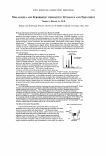98 JOURNAL OF COSMETIC SCIENCE were randomly assigned to two treatment groups, each having ten enrollees: (a) patients in group I received Acne Dressing® as a treatment application and (b) patients in group II received skin tapes as a treatment application. Each group used Acne Dressing® or skin tapes on days 1 (baseline), 3, 5, and 7. The application size was determined by the size of the patient's acne lesions. Each patient was photographed in a room with a constant temperature of 20°C and a constant relative humidity of 40-50%. Photographs of the front and bilateral facial views of each patient were taken at each visit. After five minutes, the Acne Dressing® or skin tapes were applied to inflamed papules (0.5 cm to 1.0 cm). The tapes were changed every two days by the same investigator. CLINICAL ASSESSMENT Patients were seen at baseline, defined as the visit when treatment was initiated, and again at 3, 5, and 7 days of treatment. The physician used three methods to assess acne at each visit. First, the "overall acne severity grade" was assessed by using Dr. Cunliffe's (11) grading system before and after treatment. According to this system, the grading scale was O (no acne whatsoever) to 10 (the most severe acne). The scale for the depth and width of acne lesions is: 0.25, a few small inflamed lesions 0.5, small inflammatory lesions over a wider area 1.0, more intensely inflamed lesions 1.5, intensely inflamed lesions over a wider area 2.0, deeper but non-nodular lesions 2.5, lesions similar to those in grade 2.0 but over a greater area and 3.0, much of the face involved with intensely inflamed but non-nodular lesions. Second, comparing the patients' condition with baseline photographs, the physician and the patients assessed responses to the treatment questionnaire. The questionnaire included demographic data (age and gender) and assessment of dryness, redness, oiliness, and dark pigmentation. Most questions used a five-point Likert scale with responses from "strongly disagree" to "strongly agree." At the followup visit the physician and patients assessed clinical efficacy and beneficial effects. Third, biometrological assessments were made each time after washing the face in the morning. The participants had not been allowed to wash their faces or apply cosmetics or any other topical products during the previous 15 hours. They were asked not to drink any fluids and to refrain from touching the area under investigation. At each evaluation time, the Sebumeter SM810R (C + K Electronic, Cologne, Germany) was used to assess the sebum casual level (CL, µg/cm2) before application of Acne Dressing® or skin tapes. ULTRA VIOLET B PENETRATION TEST Lambda 800 UV/VIS Spectrometer, a double mono-chromator optical system capable of doing classical transmission, absorption, and reflectance measurements in the range of 180 nm A. 3300 nm, was used to test the penetration of UVB light through Acne Dressing® and skin tapes. Measuring the transmission through both types of tape can enable us to understand the properties of the materials and is useful in avoiding UVB damage to the skin. STATISTICAL ANALYSIS The mean of the values of each biometrological parameter collected at each of the measurements was calculated for each patient. The data were analyzed using SPSS 11.0
EFFICACY TREATMENT OF ACNE VULGARIS 99 computer software (SPSS Inc, Chicago). Analysis of variance was used to compare all measures, including the overall acne severity grade, the questionnaire, and the sebum casual level. Differences before and after treatment were computed using a paired t-test. Comparisons between the two groups were computed using a nonparametic test, and comparisons were considered significant at p 0.05 and p values were two-tailed. RESULTS CLINICAL ASSESSMENT The patients ranged in age from 11 years to 35 years, with the mean being 20.7 years. There were nine males (45%) and 11 females (55%). There were no significant differ- ences in the demographic characteristics between the two treatment groups (Table II). The mean overall severity scale at baseline of patients in group I for Acne Dressing® (mean= 1.175) was higher than that of group II (mean= 1.08) (p 0.05). The average number of inflammatory lesion healing days in groups I and II were 3.2 ± 0.79 and 4.3 ± 0.83 days, respectively. At day 7, the severity of acne, assessed by patients and the physician, was significantly reduced in the treatment group compared with the skin tapes group, as demonstrated by the mean ± SD change from baseline: 0.43 ± 0.21, 0.80 ± 0.23, 0.16 ± 0.07, and 0.41 ± 0.25, respectively (p 0.05) (Table II). In the improvement of the overall acne severity grade, redness, oiliness, and the dark pigmentation of acne, the Acne Dressing® Table II Comparability of Demographic Data, Overall Severity Acne Scale, and Acne Questionnaire (n = 20) Age (mean ± SD) Sex Male Female Variable Overall acne severity scale Baseline: Patients Physician Day3: Patients Physician Day5: Patients Physician Day7: Patients Physician Questionnaire (day 7) Redness Oiliness Dark pigmentation Improvement days of inflammatory lesion healing 1 Group I: Acne Dressing®. 2 Group 2: Skin tapes. * p 0.05. Group 1 1 (Mean ± SD) 20.7 ± 3.8 5 5 1.18 ± 0.43 0.90 ± 0.33 0.80 ± 0.34 0.53 ± 0.25 0.53 ± 0.22 0.27 ± 0.14 0.43 ± 0.21 0.16 ± 0.08 1.2 ± 0.53 1.5 ± 0.53 1.8 ± 0.42 2.10 ± 0.57 3.20 ± 0.79 Group 22 (Mean ± SD) 21 ± 4.8 4 6 1.08 ± 0.41 0.65 ± 0.27 1.12 ± 0.36 0.68 ± 0.30 0.93 ± 0.24 0.68 ± 0.24 0.80 ± 0.23 0.41 ± 0.25 2.7 ± 0.84 2.4 ± 0.84 2.3 ± 0.48 4.20 ± 0.79 4.30 ± 0.83 p-Value .88 .68 .60 .09 .06 .23 .01 * .00* .00* .00* .00* .01 * .02* .00* .00*
Purchased for the exclusive use of nofirst nolast (unknown) From: SCC Media Library & Resource Center (library.scconline.org)










































































































